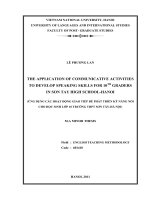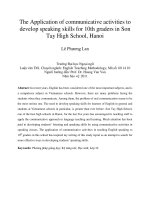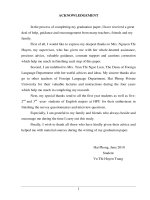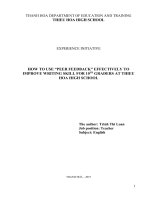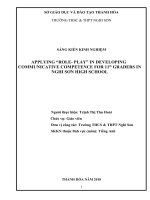Designing supplementary activities to enhance listening skill for 11th graders at Lê Lai High School, Thanh Hoá = Thiết kế hoạt động bổ trợ nhằm nâng cao kỹ năn
Bạn đang xem bản rút gọn của tài liệu. Xem và tải ngay bản đầy đủ của tài liệu tại đây (865.8 KB, 66 trang )
VIETNAM NATIONAL UNIVERSITY, HANOI
UNIVERSITY OF LANGUAGES AND INTERNATIONAL STUDIES
FACULTY OF POST-GRADUATE STUDIES
*********************
LÊ VĂN BẰNG
“DESIGNING SUPPLEMENTARY ACTIVITIES TO ENHANCE
LISTENING SKILL FOR 11
th
GRADERS AT LÊ LAI HIGH SCHOOL,
THANH HÓA PROVINCE”
“Thiết kế hoạt động bổ trợ nhằm nâng cao kỹ năng nghe của học sinh lớp 11
trường THPT Lê Lai, Thanh Hóa”
M.A MINOR PROGRAMME THESIS
FIELD: ENGLISH TEACHING METHODOLOGY
CODE: 60140111
Hanoi, 2014
VIETNAM NATIONAL UNIVERSITY, HANOI
UNIVERSITY OF LANGUAGES AND INTERNATIONAL STUDIES
FACULTY OF POST-GRADUATE STUDIES
*********************
LÊ VĂN BẰNG
“DESIGNING SUPPLEMENTARY ACTIVITIES TO ENHANCE
LISTENING SKILL FOR 11
th
GRADERS AT LÊ LAI HIGH SCHOOL,
THANH HÓA PROVINCE”
“Thiết kế hoạt động bổ trợ nhằm nâng cao kỹ năng nghe của học sinh lớp 11
trường THPT Lê Lai, Thanh Hóa”
M.A MINOR PROGRAMME THESIS
FIELD: ENGLISH TEACHING METHODOLOGY
CODE: 60140111
SUPERVISOR: LÂM QUANG ĐÔNG, Assoc. PhD.
Hanoi, 2014
i
CANDIDATE’S STATEMENT
I hereby certify that the thesis entitled “Designing supplementary activities to
enhance listening skill for 11
th
graders at Lê Lai High School, Thanh Hoá” is the
result of my own research for the Degree of Master of Arts at University of
Languages and International Studies, Vietnam National University, Hanoi and that
this thesis has not been submitted for any degree at any other university or tertiary
institution.
Signature
Lê Văn Bằng
ii
ACKNOWLEDGEMENTS
First of all, I would like to express my sincere thankfulness to my supervisor,
Assoc. Prof. Dr. Lâm Quang Đông, for his thorough reading, critical comments,
invaluable suggestions and precious corrections on my writing. Furthermore, I am
grateful to his close guidance and generous help, which have been great
encouragement to me during the process of writing and completion of the thesis.
I also would like to express my sincere thanks to all the lecturers and the
staff of the Faculty of Post-Graduate Studies at the University of Languages and
International Studies, Vietnam National University, Hanoi for their interesting
lectures and suggestions for the topic of my study.
I truly wish to thank all my colleagues and my students at Lê Lai High
School for their assistance and co-operation in completing the questionnaires and
interviews.
Last but not least, my thanks go to my dear family and friends who are
always supporting me with their consideration and encouragement.
iii
ABSTRACT
It is a common knowledge that listening is an important language skill.
However, in the reality, the teaching and learning English listening skill in Lê Lai
high school, Thanh Hóa province is somehow troublesome. This study is to design
supplementary activities to enhance the students‟ listening skill after investigating
problems of teaching English listening skills by two survey questionnaires for 40
eleventh-form students and the observation sheet for teachers of English. English
tests and teaching diaries are also carried out to elicit hidden reasons behind
participants‟ answers in the questionnaires and to help the researcher draw a vivid
picture of a listening lesson as well. From the results inferred in the analysis, the
researcher designed supplementary activities to make teaching and learning English
listening skills more effective.
.
iv
LIST OF TABLES AND CHARTS
Tables:
Table 1: Results of the pre-test
Table 2: Frequency of listening tasks in listening lessons
Table 3: Students‟ feeling when doing listening tasks in English 11
Table 4: Students‟ evaluation about the effectiveness of listening tasks
Table 5: Students‟ preferences for listening tasks
Table 6: Students‟ opinions about the way their teachers treat listening tasks
Table 7: Types of listening task in English 11
Table 8: Students‟ involvement in the tasks
Table 9: Students‟ involvement in the supplementary activities
Charts:
Chart 1: The frequency of using language games in warm-up activities
Chart 2: The effectiveness of language games in warm-up activities in listening
lessons
v
TABLE OF CONTENTS
CANDIDATE’S STATEMENT ii
ACKNOWLEDGEMENTS ii
ABSTRACT iii
LIST OF TABLES AND CHARTS iv
TABLE OF CONTENTS iv
PART I: INTRODUCTION 1
1. Rationale 1
2. Purposes and significance of the study 2
3. Research questions, methods and instruments 2
4. Structure of the thesis 3
PART II: DEVELOPMENT 5
CHAPTER ONE: LITERATURE REVIEW 5
1.1. Teaching Listening 5
1.1.1. Definition of Listening 5
1.1.2. Three stages of the listening lesson 6
1.2. Material adaptation 7
1.2.1. Definition of material adaptation 7
1.2.2. Reasons for adapting materials 8
1.2.3. Principles for adapting materials 9
1.2.4. Techniques for adapting materials 10
1.3. Relevant studies on the same topic 11
CHAPTER TWO: THE STUDY 13
2.1 Research questions re-stated 13
2.2. Participants 13
vi
2.2.1. The teacher/ researcher 14
2.2.2. The non-participant observer 14
2.3. Data collection instruments 15
2.4. Summary 16
CHAPTER THREE: FINDINGS AND DISCUSSION 17
3.1. Findings from the pre-listening test and the survey questionnaire with 11
th
graders.
17
3.1.1. Results from pre-listening test 17
3.1.2.3. Students‟ feelings when doing listening tasks in English 11 18
3.1.2.4. Students‟ evaluation about the effectiveness of listening tasks to their
listening competence. 19
3.1.2.5. Students‟ preferences for listening tasks 19
3.1.2.6. Students‟ opinions about the way their teachers treat listening tasks 20
3.1.2.7. The fact of using language games in warm-up activities 21
3.1.2.8. Effectiveness of language games in warm-up activities in listening lessons . 22
3.2. Findings from the discussion with English teachers 22
3.3. Findings from the textbook analysis 24
3.4. Findings from classroom observation and teaching diaries 26
3.4.1. Classroom observation 26
3.4.2. Teaching diaries 29
3.5. Summary 30
CHAPTER FOUR: SUGGESTED SUPPLEMENTARY ACTIVITIES 31
1. Conclusions 36
2. Limitations of the study 36
3. Suggestions for further studies 37
REFERENCES 38
vii
APPENDICES I
APPENDIX 1 I
APPENDIX 2 II
APPENDIX 3 VI
APPENDIX 4 VII
APPENDIX 5 IX
APPENDIX 6 XI
APPENDIX 7 XII
APPENDIX 8 XIII
APPENDIX 9 XIV
APPENDIX 10 XV
APPENDIX 11 XVI
APPENDIX 12 XVII
APPENDIX 13 XVIII
1
PART I: INTRODUCTION
1. Rationale
For some recent years, English has played more and more important part in
Vietnam; therefore, it has been taught in Vietnamese secondary schools as a
compulsory subject. So far, there have been remarkable changes in the way of
teaching and learning English. However, English teaching in general and teaching
listening in particular still is far from satisfactory. How to motivate students to
listen is really necessary, and is a big question to most teachers in Vietnam now. On
the other hand, each student has different language learning capacity. Especially, in
my high school in a mountainous area, students have quite low levels of English. So
it is important for me to find effective ways to increase my students‟ interest in
listening and hence improve their listening skill.
In reading relevant literature, I can see that students find listening extremely
difficult and boring due to different reasons. For instance, the listening tasks may
be monotonous, repetitive and beyond their language level, or there could be too
many new words in the listening records; the pronunciation of several words in the
record may be unfamiliar to students who are used to pronouncing them wrongly; or
the speakers may speak too fast for them to hear, as they are used to hear each word
separately in the Vietnamese language rather than focusing merely on stressed
syllables and essential key words in English, etc. Supplementary activities before
listening, while listening and after listening, especially language games, are highly
needed in order to ease the listening tasks for them while they may add fun to the
listening lesson and hence help them improve their listening skill.
There may have been a good number of interesting materials for use by
English teachers in their listening lessons, but which of them can be suitable to the
particular students at my school remains a question to answer, since each group of
students may have their own problems and capacity, as discussed earlier.
2
For the above reasons, I decide to embark on the task of designing
supplementary activities to enhance listening skill for the 11
th
graders at Lê Lai
High School, Thanh Hóa.
2. Purposes and significance of the study
The study aims at the following:
- Investigating Lê Lai High School‟s 11
th
graders‟ English proficiency and
difficulties in listening, and identify causes of the difficulties they face with;
- Analyzing listening tasks, texts and audio resources in the textbook “English
11” for 11
th
graders to finding the causes of difficulties;
- Designing possible supplementary activities needed for those listening tasks
and see which of them can help enhance these students‟ listening skill.
The study‟s output is the set of possible activities to supplement the listening
tasks in English 11 for 11
th
Graders at Lê Lai High School, which will benefit
other teachers and students at my school apart from myself and those I teach.
This provides my study with its practical significance.
3. Research questions, methods and instruments
3.1 In the attempt to achieve the afore-mentioned aims, the following
research questions are formulated so as to gather necessary information and data:
1. What is the level of the 11
th
graders‟ English listening skill, and what
difficulties may they face with in listening? Why?
2. What makes listening lessons in English 11 difficult and why?
3. What supplementary activities can be designed to help the students
address those difficulties?
3
3.2. To seek answers to the three research questions above, I will apply the
following methods and instruments:
Question 1:
- Using survey questionnaire to ask a number of 11
th
graders to find out what
difficulties they expect to encounter in listening lessons in the 11
th
grade and
causes of those difficulties;
- Discussing with English teachers at my school to gather more information on
difficulties 11
th
graders have faced with, or may have to face with, and their
causes. Part of the information from teacher discussions will also help
answer question 2 below.
Question 2:
Analyzing listening tasks, texts and audio resources in English 11 to identify
problems and their possible causes, including new words, pronunciation,
speed, intonation, etc.
Question 3:
Designing supplementary activities and listening tasks to help address the
difficulties identified so that listening tasks are easier, more suitable and interesting
to the students.
4. Structure of the thesis
As indicated above, the output of the study will be a set of supplementary
activities for use in listening lessons for 11
th
graders at Lê Lai High School. These
will form part of my thesis which is structured as follows:
Part I: Introduction – introduces the rationales for the study, purposes and
significance of the study, research questions, methods, instruments and structure of
the thesis.
4
Part II: Development, including the following chapters:
Chapter 1: Literature review – reviews the theoretical bases which are used
for the study and relevant studies concerning listening tasks for high school students
in Việt Nam in general, and English 11 text book and 11
th
graders in Việt Nam in
particular.
Chapter 2: The study – describes the participants, the methods and
instruments used for collecting necessary information for designing supplementary
activities;
Chapter 3: Findings and discussion – presents the findings from the various
instruments used and discusses them, which yields important inputs for the design
of supplementary activities;
Chapter 4: Suggested supplementary activities – identifies possible
supplementary activities whose effectiveness has been proved through some pilot
use.
Part III: Conclusion – summarizes the thesis, points out its limitations and suggests
further studies.
Naturally, after the list of references are necessary appendices.
5
PART II: DEVELOPMENT
CHAPTER ONE: LITERATURE REVIEW
The purpose of this chapter is to present the theoretical bases which are used
for this study of mine, and also reviews relevant studies concerning listening tasks
for high school students in Vietnam in general, and English 11 textbook and 11
th
graders in Vietnam in particular.
1.1. Teaching Listening
1.1.1. Definition of Listening
There are different points of view on the definition of listening. According to
Field (1998:38), listening is “an invisible mental process, making it difficult to
describe. Listeners must discriminate between sounds, understand vocabulary and
grammatical structures, interpret stress and intention, retain and interpret this within
the intermediate as well as the lager socio-cultural context of the utterance.” Mary
Underwood (1989:1) gives that “listening is the activity of paying attention to and
trying to get meaning from something we hear so that the listener must recognize
and interpret the other factors which are used to convey the messages”. According
to Susanne Flohr and Pia Paesler (2010:3- 4), listening composes important many
factors and there are three stages of listening: pre – listening, while – listening and
post – listening. Pre – listening means that the teacher makes the students aware of a
situation and activate their prior knowledge. While – listening means that the
teacher gives the students visual support or guiding questions beforehand. Post –
listening is the stage where the students become active and work with what they had
heard”. All in all, it is a complex, active process of interpretation in which listeners
matches what they hear with what they already know. Listening involves a sender, a
message, and a receiver (the listener) and also consists of three stages: pre –
listening, while – listening and post – listening.
6
1.1.2. Three stages of the listening lesson
In order to help learners get most from a listening lesson, a lesson plan of
listening is usually divided into three stages: Pre-listening, While-listening and
Post-listening.
1.1.2.1. Pre-listening
In teaching real-life listening, methodologists have taken expectation and
purposes of listeners into account. These make listeners feel as in real-life listening
situation in their native language. The teachers can effectively help their students to
arouse their expectations and see the purpose before a listening lesson. Therefore, in
pre-listening “It seems a good idea when presenting a listening passage in class to
give students some information about the content, situation and speakers before
they actually start listening.” (Ur,1992, p.4)
According to Underwood (1990), pre-listening work can consist of a whole
range of activities, including the students looking at pictures, discussion of the
topic/ situation, a question and answer session, written exercises, following the
instructions for the while-listening activity and consideration of how the while-
listening will be done.
1.1.2.2. While-listening
The while-listening stage consists of activities that students are asked to do.
The purpose of while listening activities is to help students develop their skills of
listening to the spoken language. Rixon (1986) points out the purposes of while
listening stage is to challenge and guide students to handle the information and the
message from the listening text. Activities of this stage must be interested and
carefully chosen. They must vary at different level and in different cases.
1.1.2.3. Post-listening
Post-listening activities in post-listening stage are done after the listening is
completed. Some post-listening activities are extensions of the work done at the pre-
7
listening and while-listening stage and some relate only loosely to the listening text
itself.
According to Underwood (1989), the first purpose of post-listening activities
is to check how well the students understood and whether they have completed the
listening task. The second purpose is to reflect on why some students have failed to
understand or miss parts of the passage. The next is to expand on the topic or the
language of the listening text. The fourth purpose is to give students opportunity to
consider the manner and attitude of the speaker in the listening text. In addition, the
general factors listed in pre-listening and while-listening , Underwood (1989)
indicates that the attention should be given to the following factors in selecting post-
listening activities: How much language work you wish to do in relation the
particular listening text; whether there will be time to do much post-listening work
at the end of the listening lesson; whether the post-listening work should consist of
speaking, reading or writing; whether the post-listening stage is seen as an
opportunity for pair or group work; whether it is necessary to provide post-listening
activities which can be done outside the classroom; how to motivate the chosen
activity will be and whether it can be more motivating.
1.2. Material adaptation
1.2.1. Definition of material adaptation
Madsen and Bowen (1978: ix) argues that adaptation is an action of
employing „one or more of a number of techniques: supplementing, expanding,
personalizing, simplifying, modernizing, localizing, or modifying cultural/
situational content‟. Similarly, Tomlinson (1998) believes that adaptation means
“reducing, adding, omitting, modifying and supplementing.”
It is also quite necessary to differentiate the terms “adapting” and “adopting”.
Adaptation is a process subsequent to, and dependent on adaptation .In addition,
while adoption deals with the whole course book, adaptation is only concerned with
8
the parts that make up the whole. Last but not least, adoption is related to
evaluation, but adaptation is related to changing or adjusting various parts
In short, adaptation matches internal to external factors. It involves changing
some of the internal characteristics of a course book to better suit a particular
circumstance.
1.2.2. Reasons for adapting materials
Cunningham (1995) has pointed out that “Materials are not always clear
regarding the methodology they use in terms of „what‟ and „how‟ to teach. There
are also cases of inconsistency between stated and actual methodology. Moreover,
course book cannot relevant to all teaching/ learning contexts”. Hence, adapting
materials is badly in need. Teachers should adapt published materials according to
their students‟ needs and proficiency.
Besides that, it will be useful to compare our own reasons with those in the
following list proposed by McDonough and Shaw (1993: 86). This list indicates
some of the possible areas of mismatch which can be dealt with by adapting in this
study.
- Not enough grammar coverage in general
- Not enough guidance on pronunciation
- Not enough practice of grammar points of particular difficulty to these
learners
- Subject- matter inappropriate for learners of this age and intellectual level
- The communicative focus means that grammar is presented unsystematically
- Amount of material too great/ too little to cover in the time allocated to
lessons
9
- Too much/ too little variety in the activities
- Dialogues too formal, and not really representative of everyday speech
- Vocabulary list and a key to the exercises would be helpful
- Accompanying tests needed
In this study, the theories of material adaptation as well as the list of reasons
presented above will be certainly helpful for modifying some listening tasks in
listening sections of English 11.
1.2.3. Principles for adapting materials
It is obvious that material adaptation is necessary. However, this process can
not be done casually and arbitrarily. It must follow some certain principles.
According to McDonough and Shaw (1993), adapting materials must ensure three
principles, namely „personalizing‟, „individualizing‟ and „localizing‟:
„Personalizing‟ refers to increasing the relevance of content in relation to learners‟
interests and their academy, educational or professional needs.
„Individualizing‟ addresses the learning styles both of individuals and of the
numbers of a class working closely together.
„Localizing‟ considers the matters of international geography of English language
teaching and recognizes that what may work well in this learning environment may
not do so in that environment.
In brief, the above principles play a vital role in adapting materials. In this
study, the author also bases on these principles for designing supplementary
activities for the listening lessons in English 11.
10
1.2.4. Techniques for adapting materials
To adapt materials, McDonough and Shaw (1993) offer a list of techniques as
follows:
Adding: The term “Addition‟ mainly means that materials are supplemented by
adding more to them “while taking into account the practical effect on time
allocation‟. There are two ways of adding, namely extending or expanding.
Extending means teachers supply more of the same type of materials to make a
quantitative change in the material. Expanding means adding some things
different to the material to make qualitative change.
Deleting or omitting: Like technique of addition, a teacher can delete or omit
materials both quantitatively ( by subtracting ) or qualitatively ( by abridging )
Modifying: „Modification‟ at one level is a very general term in the language
applying to any kind of change. In order to introduce further possibilities for
adaptation, we should restrict its meaning here to an internal change in the
approach or focus of an exercise or other pieces of materials. It is a rather
important and frequently used procedure that is like all other techniques; it can be
applied to any aspect of „content‟. It can be sub-divided into two kinds: rewriting
and restructuring.
Simplifying: When simplifying, teachers can make many elements of a language
course such as the instructions, explanations, exercises or activities become easier
and more accessible to learners.
Re-ordering: Re-ordering refers to the possibility of putting parts of a course
book in a different order. This may mean adjusting the sequence of presentation
within a unit or taking units in a different sequence from that originally intended.
Tanner and Green (1998: 122) also propose four different techniques for adapting
materials. They are changing, removing, replacing and adding.
11
Changing: Changing means making small changes to the existing material in the
course book to make the material more appropriate to students.
Removing: Removing means that a course book‟ activity will be removed from
the lesson.
Replacing: Replacing means that one activity in an area not covered sufficiently
in the book will be replaced by a more suitable activity.
Adding: It means that the teacher can add an extra activity in an area not covered
sufficiently in the book.
In short, there are a large variety of techniques which can be used to adapt a
material. However, the most commonly used ones may be modifying, replacing,
adding and simplifying. As a teacher of English, the researcher thinks that these
techniques can be used individually or in combination with others according to
particular learning contexts as well as students‟ level, needs and interests. Although
the title of the thesis is designing supplementary activities, the word supplementary
here is inclusive in the sense that not only addition will be used, but also other
necessary adaptation techniques among those listed above.
1.3. Relevant studies on the same topic
Before I carried out this study, there were some relevant studies on my topic.
For example: Hoàng Phương Thảo (2010), “Improving students‟ listening
comprehension through focused on listening tasks”, M.A. thesis, University of
Languages and International Studies, Việt Nam National University, Hà Nội. In this
study the researcher mainly focused on students‟ attitudes towards listening learning
basing on the survey questionnaire, and then she gave out some suggestions to
improve students‟ listening comprehension. The good point of this study is that the
researcher investigated the students‟ attitudes to wards listening learning so well,
but the limitation of this study is the researcher did not give out the concrete
12
solutions through each listening activity or each listening lesson in the text book
basing on the results of the survey questionnaire about the students‟ attitudes. The
topic 2, Nguyễn Diệu Huyền (2010), “ A study on the effects of pre-listening
activities on the listening performance of non-major 10
th
grade students at Nguyen
Gia Thieu high school, Ha Noi” ”, M.A. thesis, University of Languages and
International Studies, Việt Nam National University, Hà Nội. In this study, the
researcher investigated the effects of pre-listening activities on the listening
performances of grade 10 students at Nguyen Gia Thieu high school by using the
observation sheets and survey questionnaire in three classes. The good point of this
study is that the researcher pouted out the effects of pre-listening activities on the
listening performance, for example: Students lack vocabulary and structures related
to the topic of the listening passage, encounter their limitted background
knowledge, lack preparation for the task, unfamiliar topics and the speed of the
listening. Besides, the limitation of this study is that the researcher did not give out
the concrete solutions in pre-listening activities through each listening lessons.
Driving from the good points and the limitations of those two studies, in my study
after investigating the causes and the difficulties my studennts get in each listening
lesson, I designed the concrete supplementary activities through each unit in
eleventh text book to enhance the listening skill for my students.
13
CHAPTER TWO: THE STUDY
2.1 Research questions re-stated
In the attempt to achieve the aims of the study, the following research
questions are formulated so as to gather necessary information and data:
1. What is the level of the 11
th
graders‟ English listening skill, and what
difficulties they may face with in listening? Why?
2. What makes listening lessons in English 11 difficult and why?
3. What additional activities can be designed to help the students address
those difficulties?
The research question 1 is used to help the researcher know the level of the
11
th
graders‟ English listening skill, what difficulties they get in listening and the
reasons why they get those difficulties. The research question 2 is to help the
researcher find out the causes making listening lessons in English 11 difficult. From
the results of the research question 1 and the research question 2, the researcher can
design the supplementary activities to help students address those difficulties.
2.2. Participants
This study was carried out in the school year 2013-2014 at Lê Lai High
School, where the data were collected, analyzed and improvement strategies were
tried out. The people who took part in this study were:
14
2.2.1. The teacher/ researcher
The researcher has been teaching English at Lê Lai High School for 10 years.
He is thirty two years old. He graduated from Vinh University and now he is
attending a Master Course in TESOL at University of Languages and International
Studies (ULIS), VNU.
2.2.2. The non-participant observer
The observer was a teacher of English at Lê Lai High School. She graduated
from University of Languages and International Studies (ULIS), VNU. She is at the
age of forty and has been teaching English for 15 years. She was invited to take part
in this study to help the researcher observe the classroom and fill in the observation
sheets. She has a set of checklist involving students‟ concentration on the listening
activities, their involvement in the activities and their enjoyment and persistence.
She also observed students‟ reactions to the supplementary listening activities and
their preferences for listening activities. All the information from collected from the
class observations are used to evaluate the effectiveness of the supplementary
activities.
2.2.3. The students
The students were forty 11
th
graders (18 females and 22 males) in the
researcher‟s class - Class 11A1- at Lê Lai High School in the academic year 2013-
2014. Their ages were between 16 and 17. They came from different communes of
Ngọc Lặc district. All of them had learnt English since Grade 6. However, their
English proficiency was quite low, especially listening skill. Most of them did not
pay attention to listening study as they thought that this skill was not very important
and especially it was not tested in any National Examination. In the school year
2013-2014, the student had a 45 –minute period per week for the listening skill.
15
2.3. Data collection instruments
To seek answers to the three research questions above, I will apply the following
methods and instruments:
Question 1:
To answer the research question 1, I used the survey questionnaire to ask a
number of 11
th
graders involving in the study and ask them to do a pre-test to find
out what difficulties my students get in listening lesson in the 11
th
grade and causes
of those difficulties. After doing the survey questionnaire, I also discussed with my
English colleagues about the difficulties they encounter when teaching listening
skill to their 11
th
grade students and which solutions they usually use to deal with
those problems. Thanks for those discussions; I knew more the difficulties 11
th
graders have faced with, or may have to face with and their causes and the
techniques they use to help their students overcome those difficulties.
Part of the
information from teacher discussions will also help answer question 2 below.
Question 2:
To answer the research question 2, besides a part of the result of the research
question 1. I studied and analyzed listening tasks, texts and audio resources in
English 11 text book to identify problems and their possible causes, including new
words, pronunciation, speed, intonation, etc.
Question 3:
From the results of the research question 1 and the research question 2, I
designed supplementary activities and listening tasks to help the students address
the difficulties identified. Designing those supplementary activities and listening
tasks is to make listening tasks easier, more suitable and interesting to the students.
16
Designing supplementary activities and listening tasks to help address the
difficulties identified so that listening tasks are easier, more suitable and interesting
to the students.
2.4. Summary
To conclude, this chapter presents the methodology of the study. In other
words, it describes the aims, context, participants and instruments of the study.
Given the collected data, Chapter 3 will depict the data analysis and the study
results.



